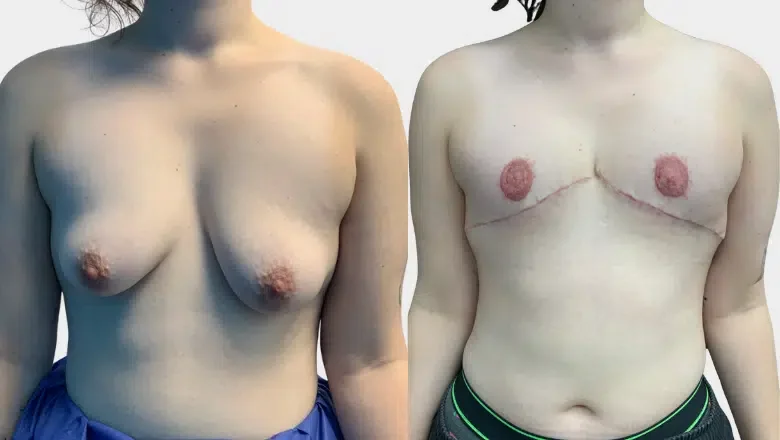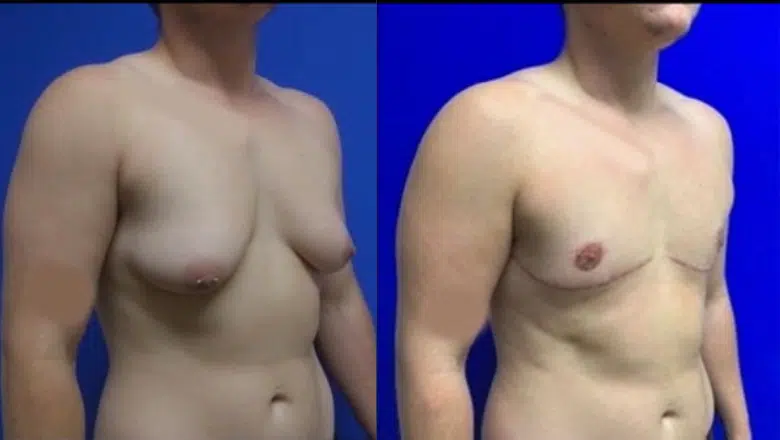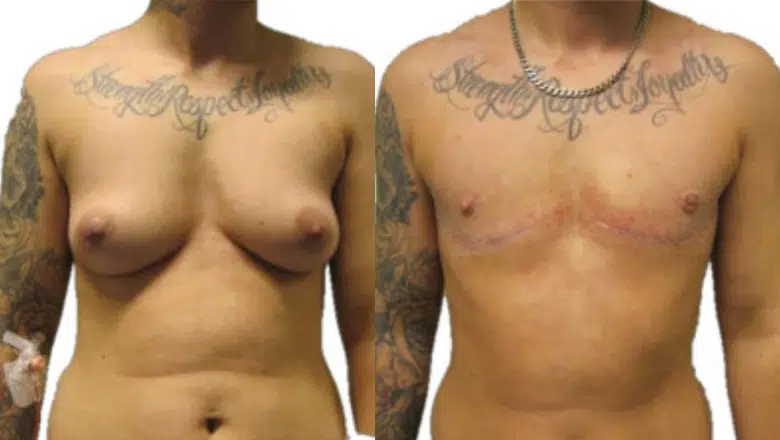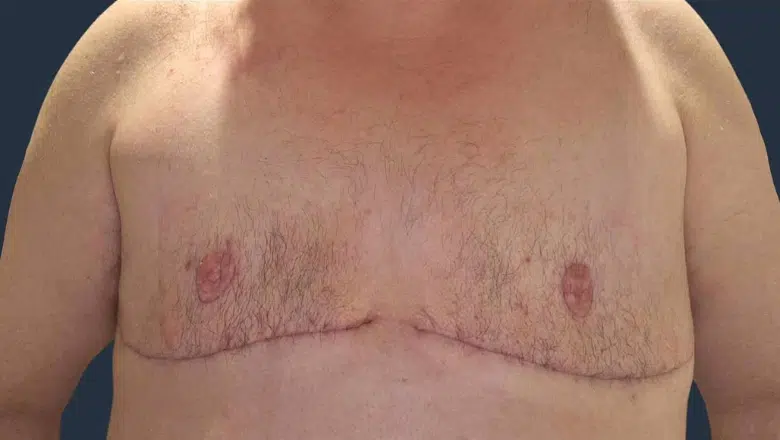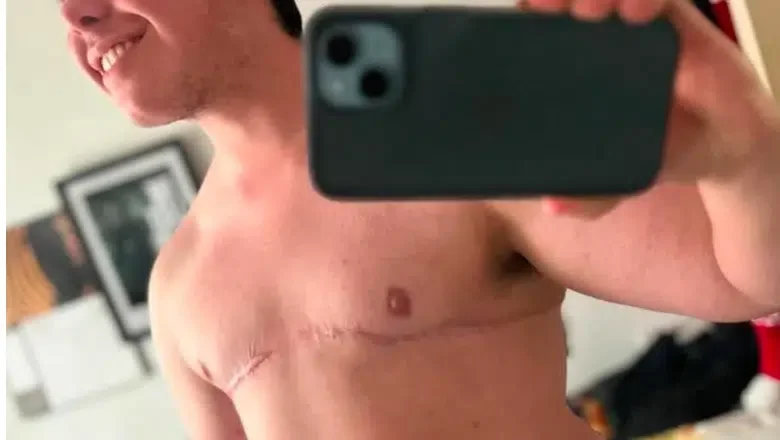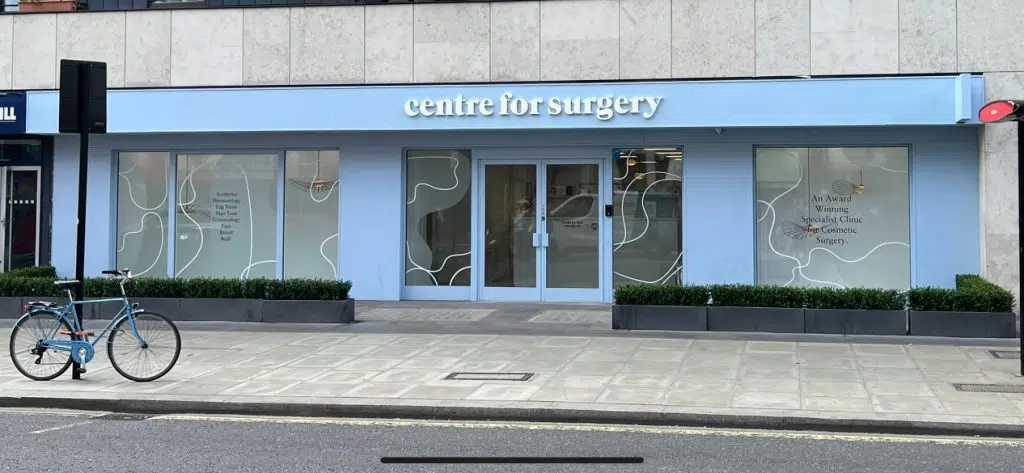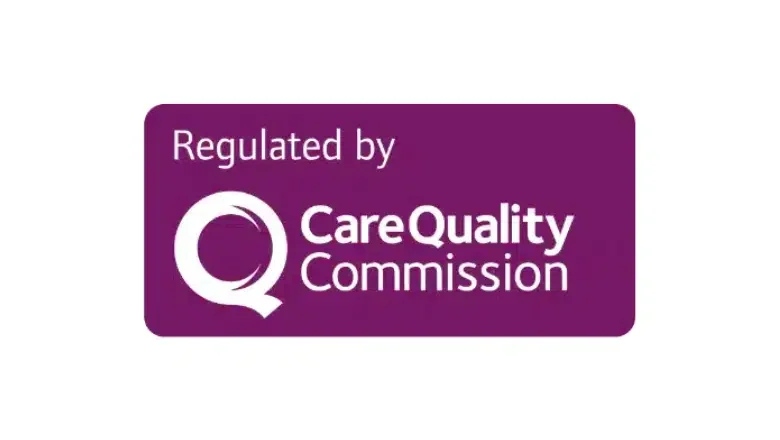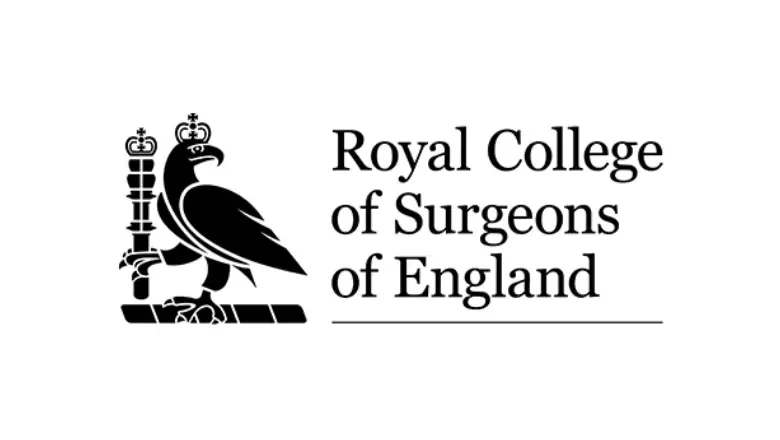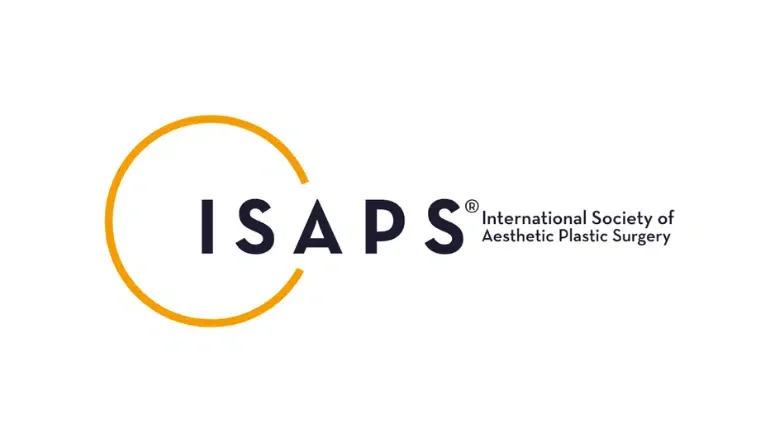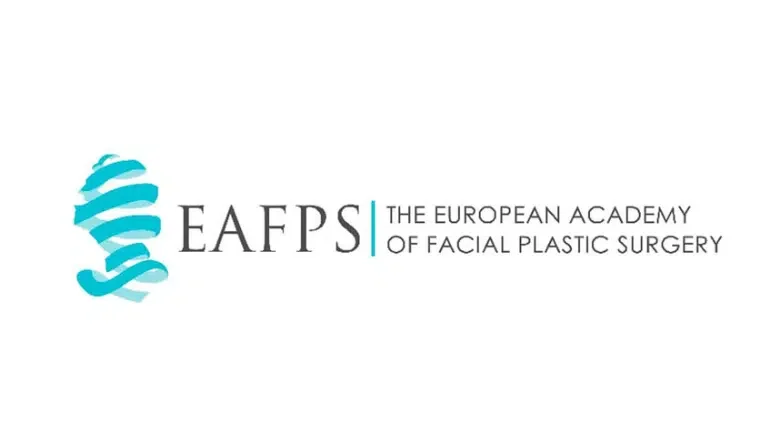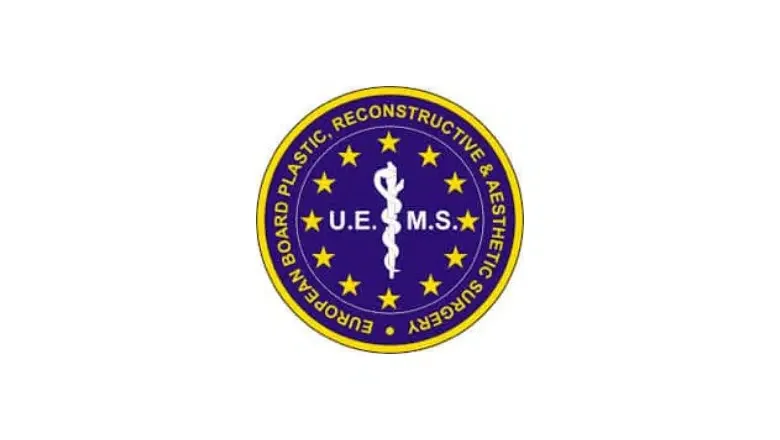Double Incision Top Surgery London & UK
Experience the life-changing transformation with double incision top surgery, providing a more masculine chest contour and a renewed sense of confidence
Located in the heart of London, Centre for Surgery is renowned for its commitment to delivering bespoke gender-affirming procedures, with a particular focus on the double incision top surgery, a type of FTM Top surgery. In our practice, we emphasise an empathetic, personalised approach, acknowledging the unique journey of each patient.
The double incision top surgery, also known as bilateral mastectomy, is a surgical procedure we frequently perform at our Baker Street clinic. It is more invasive than the keyhole mastectomy technique. Designed for transgender men and non-binary individuals who have moderate to large amounts of chest tissue, this procedure is pivotal in aligning physical appearance with gender identity. It helps to mitigate feelings of distress often associated with gender dysphoria, or the incongruity between one’s physical body and gender identity.
Our team at Centre for Surgery understands the courage it takes to embark on this transformative journey. Thus, we strive to provide an atmosphere of respect and compassion, ensuring our patients feel valued and comfortable throughout the entire process. From the initial consultation to the final check-up, we’re here to guide and support you.
RELATED: FTM Top Surgery FAQs
Each double incision top surgery is meticulously planned and executed by our skilled surgeons who have an in-depth understanding of the unique needs of transgender and non-binary patients. Utilising state-of-the-art surgical techniques and equipment, we’re dedicated to achieving the best possible outcomes, while prioritising your safety and wellbeing.
Our track record speaks for itself – we have helped thousands of transgender and non-binary individuals in London and beyond to lead more fulfilled, happier lives by alleviating feelings of gender/breast dysphoria.
Is it time for you to begin your surgical gender confirmation journey? Centre for Surgery is prepared to stand beside you. We understand the significance of this step and are committed to providing the utmost care and support as you move forward. So, when you’re ready, reach out to us and we’ll be there to help you turn the page to a new chapter in your life.
What is Double Incision Top Surgery?
Double incision top surgery, also known as a double incision mastectomy or bilateral mastectomy, is a gender confirmation surgical technique primarily used for transgender men and non-binary individuals with a larger amount of chest tissue.
The term ‘double incision’ refers to the surgical technique itself, where two horizontal incisions are made along the bottom border of the pectoral muscles. Once the incisions are created, the skin is elevated, allowing the surgeon to access and meticulously remove the breast tissue underneath. This technique allows for the removal of a significant amount of skin and breast tissue, effectively creating a flatter, more masculine chest contour.
In this procedure, the nipples and areolas are typically removed, resized, and grafted back onto the chest in a position that complements the new masculine chest shape. This step, known as free nipple grafting, helps to ensure the chest appearance is more congruous with the patient’s gender identity.
Your surgeon may also recommend additional contouring alongside your double incision top surgery, a preventative measure that can help avoid the formation of ‘dog ears.’ This term refers to the potential excess skin and fat that can protrude on the sides of the incision site, often giving an uneven appearance to the chest.
The double incision mastectomy is typically performed as an outpatient procedure, meaning patients can return home on the same day. It usually takes approximately two hours and is conducted under general anaesthesia for patient comfort.
Remember, it’s crucial to choose a surgeon who is experienced and understanding of the unique needs of transgender and non-binary patients when considering double incision top surgery. Our surgeons at Centre for Surgery in London are well-versed in these procedures and dedicated to helping each patient on their unique journey towards gender affirmation.
Dr Spiros Vlachos – Expert in Masculinising Chest Surgery
Dr Spiros Vlachos is a highly skilled specialist in masculinising chest surgery, offering a full range of procedures to help individuals achieve their desired chest contour. With extensive experience in gender-affirming surgery, he is renowned for his expertise in double incision mastectomy, nipple-sparing techniques, periareolar mastectomy, and inverted-T top surgery.
Dr Vlachos takes a personalised approach, ensuring each patient receives a tailored surgical plan that aligns with their aesthetic goals and anatomical needs. His meticulous technique prioritises natural-looking results, minimal scarring, and optimal nipple positioning.
Committed to delivering safe and compassionate care, Dr Vlachos supports patients throughout their surgical journey, from consultation to recovery. Whether seeking a more defined masculine chest or a refined surgical outcome, Dr Vlachos’ expertise ensures exceptional results with a focus on patient well-being.
Double Incision Mastectomy Before & After Photos
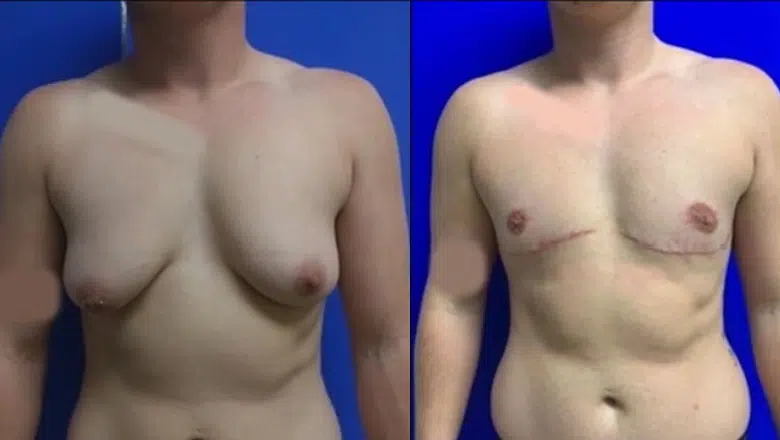
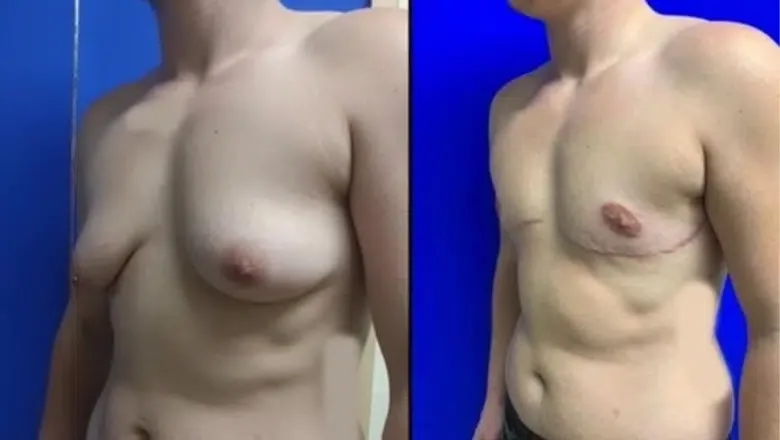
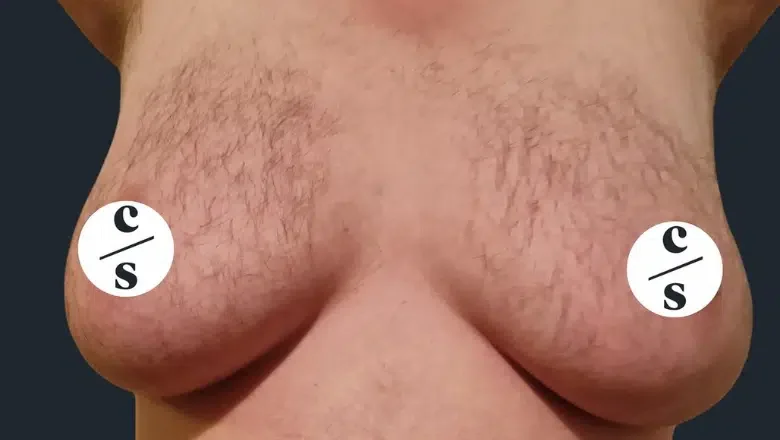
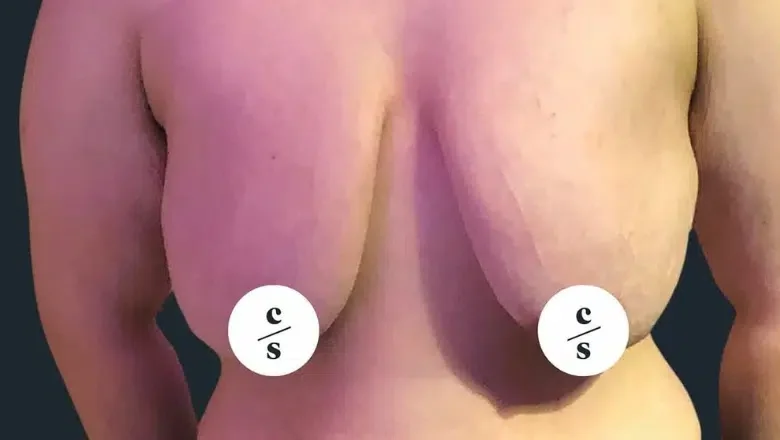
Benefits of Double Incision Mastectomy
Double incision top surgery, or double incision mastectomy, offers numerous benefits for transgender men and non-binary individuals who wish to align their physical appearance more closely with their gender identity. Here are some of the main benefits associated with this procedure:
Significant Chest Contouring
One of the primary benefits of the double incision method is its ability to deliver substantial chest contouring. This technique effectively removes larger amounts of chest tissue, making it possible to achieve a more masculine, flat chest profile.
Nipple and Areola Resizing and Repositioning
With the double incision technique, nipples and areolas can be resized and repositioned to create a more masculine appearance. This can be a significant factor in reducing feelings of gender dysphoria and enhancing self-confidence.
Relief from Gender Dysphoria
For many transgender men and non-binary individuals, top surgery can bring profound relief from the distress caused by gender dysphoria. By aligning physical characteristics with gender identity, this surgery can contribute to improved mental health and increased self-esteem.
Increased Comfort
By removing excess chest tissue, individuals can experience increased physical comfort in day-to-day life. This includes the freedom from binders, which can be uncomfortable or even painful to wear over extended periods.
Personal Affirmation
For many, top surgery is a critical step in affirming their gender identity. This procedure can serve as a pivotal moment in a person’s transition, helping to affirm their identity and live authentically.
Improved Quality of Life
Following recovery, many patients report an enhanced quality of life, including improved body image, increased social confidence, and greater comfort in their bodies.
Am I suitable for Double Incision Top Surgery?
Choosing to undergo double incision top surgery is a deeply personal decision, and determining whether you are the right candidate for this procedure involves several factors.
Generally, you may be a suitable candidate for double incision top surgery if:
You experience gender dysphoria
This is a condition where a person experiences distress due to a disconnect between their gender identity and their assigned gender at birth. If you’re a transgender man or a non-binary person who experiences distress due to your chest, this surgery may be a part of your transition process.
You have moderate to large amounts of chest tissue
The double incision technique is typically used for individuals who have a larger amount of chest tissue that wouldn’t be adequately addressed by other techniques such as keyhole or periareolar top surgery.
You’re in good general health
As with any surgical procedure, it’s important that you’re in good health to minimise potential complications. This means you should have no serious underlying medical conditions, and if you’re a smoker, you’ll be asked to quit well in advance of the surgery.
You understand the procedure and have realistic expectations
Understanding the potential outcomes and limitations of the surgery is crucial. The double incision technique does result in more visible scarring than other techniques and involves a complex process of nipple grafting.
You’re ready for the recovery process
Recovery from double incision top surgery can take several weeks and requires you to follow post-operative care instructions closely.
Mental Health Considerations
As part of the evaluation process, a mental health professional will typically assess your readiness for the procedure, including your ability to provide informed consent and manage the emotional aspects of surgery.
Preparing for Double Incision Mastectomy
The decision to undergo a double-incision mastectomy is significant and requires thoughtful preparation. Here are some steps you can take to prepare yourself for this procedure:
Medical Consultation
Before anything else, you should have a comprehensive consultation with your surgeon. This is an opportunity to discuss your expectations, learn about the procedure, and have all your questions answered. The surgeon will also assess your health and discuss any potential risks and complications.
Psychological Assessment
Many surgeons require a mental health professional letter confirming your surgery readiness. This assessment helps ensure that you understand the implications of the surgery and can cope with the emotional aspects of the transition.
Healthy Lifestyle
In the weeks before your surgery, it’s vital to maintain a healthy lifestyle. This includes a balanced diet, regular exercise, adequate sleep, and avoiding unhealthy behaviours such as smoking or excessive alcohol consumption.
Medications
Your surgeon may ask you to stop taking certain medications or supplements before your surgery. It’s essential to follow these instructions to reduce the risk of complications.
Arrangements for Recovery
Make necessary arrangements for your recovery period. This might include time off work or school, arranging for help at home, and setting up a comfortable recovery area where you can rest and heal.
Emotional Preparation
Undergoing surgery can be emotionally challenging. It can be helpful to seek support from friends, family, or support groups. Mental health professionals can also assist in navigating these feelings.
Understand the Procedure
Understanding what to expect before, during, and after your surgery can alleviate some anxieties. Your surgeon will provide detailed information, but don’t hesitate to ask questions if anything is unclear.
Prepare Your Home
Stock your fridge with easy-to-prepare meals and ensure you have essentials at home, including items like ice packs for swelling and button-up shirts that are easy to put on post-surgery.
The journey towards gender affirmation is unique for each individual, and preparation can look different for everyone. The crucial part is that you feel ready—both physically and emotionally—for the transition ahead. Your care team at the Centre for Surgery is dedicated to guiding you through this process, ensuring that you feel supported and informed every step of the way.
Double Incision Mastectomy Procedure
Double incision top surgery, also known as a double incision mastectomy or bilateral mastectomy, is a gender confirmation procedure often selected by transgender men and non-binary individuals with a moderate to large amount of chest tissue. This is how the procedure typically unfolds:
Preparation
On the day of your surgery, the surgical team will prep you. This will typically involve a final discussion with your surgeon about what to expect during and after the procedure. You will be administered general anaesthesia, which will ensure that you’ll be comfortable and won’t feel any pain during the surgery.
Making the Incisions
Once the anaesthesia has taken effect, the surgeon will make two horizontal incisions on your chest, generally along the lower border of the pectoral muscles.
Removal of Breast Tissue
The skin between the two incisions is then lifted, allowing the surgeon to access and remove the breast tissue underneath.
Reshaping the Chest Contour
The surgeon will carefully sculpt the remaining tissue and skin to create a flatter, more typically masculine chest contour.
Nipple Grafting
The nipples and areolas are usually removed, resized, and then grafted back onto the chest in a position that matches a more masculine appearance.
Closing the Incisions
The incisions are then closed, often with absorbable sutures, and dressings are applied. The procedure may also involve inserting temporary drains to remove any excess fluid.
This procedure typically takes around two to three hours to complete, depending on the specifics of the case. Following surgery, you must wear a special postoperative garment to help reduce swelling and support your new chest contour as it heals.
Recovery after Double Incision Top Surgery
Recovery after a double incision top surgery is a gradual process that requires careful attention to post-operative care instructions. Here are the general steps you can expect:
Immediate Postoperative Period
After the surgery, you’ll be taken to a recovery room where medical staff will closely monitor your vital signs. Once you’re awake and stable, you’ll be allowed to go home. You’ll need someone to drive you home and ideally stay with you for the first few days.
Pain Management
Some discomfort is expected after surgery, but this can usually be managed with prescribed pain medication. Over time, discomfort should decrease.
Drainage Tubes
If drains were placed during surgery to prevent fluid accumulation, they’ll typically be removed within a week after the surgery.
Dressings and Compression Garment
Your chest will be wrapped in dressings and a compression garment, which you’ll need to wear for a period of time specified by your surgeon. This garment helps to reduce swelling and supports the chest as it heals.
Activity Level
You’ll be encouraged to move around shortly after surgery to promote good blood circulation, but strenuous activities, heavy lifting, and raising your arms above your head should be avoided for at least a few weeks.
Follow-Up Appointments
You’ll have several follow-up appointments with your surgeon to monitor your healing progress. Attending these appointments and discussing any concerns you may have is important.
Scar Care
Scarring is a common part of recovery from double incision top surgery. Your surgeon will provide specific instructions on how to care for your scars to promote healing and reduce their visibility over time.
Emotional Recovery
Emotional recovery is just as important as physical recovery. During this time, it can be helpful to reach out to supportive friends, family members, or support groups.
In general, you can expect to return to non-strenuous work or school within 2-3 weeks after surgery. However, full recovery can take several weeks to months, and the final results of the surgery may not be evident until about a year after surgery, as it takes time for swelling to subside and scars to fade.
Risk and Potential Complications of Double Incision Mastectomy
Like any surgical procedure, a double incision mastectomy carries potential risks and complications. It’s important to discuss these thoroughly with your surgeon so that you can make an informed decision about your care. Here are some potential risks associated with this procedure:
Bleeding
There’s a risk of bleeding during and after the surgery. Your surgeon will take precautions to minimise this risk, but in some cases, additional intervention or even a blood transfusion may be necessary.
Infection
Despite stringent sterile techniques taken at our facility, there is always a risk of infection with any surgical procedure. Infections are usually treatable with antibiotics, but in severe cases, additional surgery may be required.
Scarring
Double incision top surgery results in two horizontal scars across the chest. The appearance of these scars will vary depending on individual healing responses and post-operative scar care. Some people may develop hypertrophic or keloid scars, which are raised and more noticeable.
Changes in Sensation
Alterations in the chest and nipple sensations are common after surgery. While some people regain full or partial sensation over time, for others, the loss of sensation can be permanent.
Issues with Nipple Grafts
The process of removing and grafting the nipples can lead to complications such as loss of the nipple graft or differences in nipple size or colour.
Asymmetry
There may be some asymmetry in the chest contour or nipple placement. While every effort is made to create symmetry, minor differences are normal.
Anaesthetic Risks
As with any procedure that requires anaesthesia, there are associated risks, including allergic reactions and problems with breathing.
Psychological Effects
Emotional reactions to surgery vary greatly and can include depression or anxiety, body image struggles, or feelings of regret.
Need for Revision Surgery
In some cases, additional procedures may be required to correct complications or to achieve the desired results.
It’s crucial to discuss all possible risks and complications with your surgeon before making your decision. Each individual’s risk profile is unique, depending on factors such as overall health, lifestyle habits, and the specific surgical techniques used.
At Centre for Surgery, we believe in a patient-centred approach, ensuring that you are fully informed and comfortable with all aspects of the procedure and its risks before proceeding.
Why Choose Centre for Surgery for your Double Incision Mastectomy?
At Centre for Surgery, we are acutely aware of the unique struggles faced by the LGBTQIA+ community when it comes to healthcare. We recognise the importance of creating a supportive and affirming environment for transgender and non-binary individuals, where they can feel comfortable and reassured as they embark on their gender affirmation journey.
Our dedicated team of professionals are not just trained in their medical specialties, but also in providing culturally competent care that respects and affirms the identities of our patients. We use gender-inclusive language, we listen, and we take the time to understand each individual’s unique needs and concerns. Every member of our team is committed to promoting a positive, respectful and safe environment for all our patients.
Our expertise in performing gender-affirming procedures, including double incision top surgery, stems from our long-standing experience in this field. We have helped hundreds of transgender and non-binary individuals achieve a physical appearance that aligns with their true identity, resulting in improved self-confidence and overall well-being.
From the initial consultation to post-operative care, our priority is to make every step of your journey with us as comfortable and stress-free as possible. This includes addressing any anxieties you may have, answering all your questions, and providing thorough information about what to expect.
Choosing Centre for Surgery for your double incision top surgery means choosing a centre where your identity is seen, your needs are understood, and your well-being is the priority. Our goal is to be an active part of your transformative journey, providing expert surgical care in an environment where you feel seen, respected, and supported.
FAQs
-
What is a double incision mastectomy?A double incision mastectomy is a surgical procedure commonly chosen by transgender men and non-binary individuals as part of their gender affirmation journey. It involves the removal of breast tissue and reshaping the chest to create a more masculine appearance.
During the surgery, two horizontal incisions are made across the chest, typically positioned along the lower border of the pectoral muscles. The skin and breast tissue are then dissected and removed, allowing for the creation of a flatter chest contour.
In addition to tissue removal, the nipples are typically resized and repositioned to align with the new masculine chest appearance. This is achieved through grafting techniques, where the nipples are detached, resized, and then reattached in a more suitable position on the chest.
Double incision mastectomy is typically performed under general anesthesia and is considered a major surgical procedure. Recovery time varies for each individual but generally involves a healing period of several weeks, during which physical activities may be restricted.
This procedure has been highly effective in reducing gender dysphoria and helping transgender individuals achieve a more congruent body image. It is important to consult with a qualified surgeon experienced in gender affirming surgery to discuss the specifics of the procedure and determine if it is the right choice for you. -
Will I need drains after double incision mastectomy?At Centre for Surgery, our advanced surgical techniques aim to minimise the need for post-surgical drains or tubes following a double incision mastectomy. We understand that drains can be uncomfortable and restrictive for patients, and we strive to provide a smoother and more comfortable post-operative experience.
However, it's important to note that the decision to use drains ultimately depends on the specific circumstances of each patient's surgery and the surgeon's professional judgment. In some cases, drains may still be necessary to help prevent fluid buildup or manage any potential complications.
During your consultation with our experienced surgeons, they will thoroughly assess your individual situation and discuss the surgical plan, including the use of drains if deemed necessary. They will provide you with detailed information and answer any questions you may have regarding drains or alternative methods of managing post-operative fluid accumulation.
Our priority is to ensure your comfort and a successful recovery following your double incision mastectomy. Rest assured that our surgeons will employ the most appropriate techniques to optimise your surgical experience and minimise any potential discomfort or inconvenience. -
When can I return to work after bilateral mastectomy?The timeline for returning to work after a bilateral mastectomy can vary depending on several factors, including the type of work you do, the extent of the surgery, and your individual healing process. It's important to follow your surgeon's specific recommendations and consider any physical demands or restrictions associated with your job. However, here are some general guidelines:
Desk Job or Light Physical Work: If you have a desk job or work that doesn't involve physical exertion, you may be able to return to work within 1-2 weeks after surgery. However, keep in mind that you may still experience some discomfort and fatigue during this time, so listen to your body and take breaks as needed.
Moderate Physical Work: If your job involves moderate physical activity, such as light lifting or extended periods of standing, you may need to take a longer period off work. Typically, 2-4 weeks of recovery time is recommended before returning to this type of work. It's important to gradually increase your activity level and avoid overexertion.
Physically Demanding Work: If your job requires heavy lifting, strenuous physical activity, or repetitive motion, you may need to take an extended leave of absence. It's essential to allow your body ample time to heal and recover before returning to this level of activity. Your surgeon will provide guidance on when it is safe to resume such demanding work, which may be around 6-8 weeks or longer. -
How do you sleep after double incision mastectomy?Sleeping comfortably after a double incision mastectomy can be a concern during the recovery period. Here are some tips to help you find a comfortable sleeping position:
Elevate your upper body: Sleeping with your upper body slightly elevated can help reduce swelling and discomfort. You can achieve this by using extra pillows or a wedge pillow to prop yourself up. This position can also alleviate pressure on the chest area.
Pillow support: Place pillows strategically around your body to provide support and help maintain a comfortable sleeping position. This can include placing pillows under your arms, between your legs, or supporting your back as needed.
Side sleeping: Many patients find it more comfortable to sleep on their side after a double incision mastectomy. You can use pillows to support your body and keep pressure off the surgical site. Place a pillow between your knees to align your spine and provide additional support.
Avoid sleeping on your stomach: It's generally advised to avoid sleeping on your stomach during the initial stages of recovery to prevent putting pressure on the chest area. This position can cause discomfort and may hinder the healing process.
Loose-fitting clothing: Wear loose-fitting and comfortable clothing to bed, such as button-up shirts or loose nightgowns. Avoid tight or constricting garments that may irritate the surgical area.
Listen to your body: Pay attention to your body's cues and adjust your sleeping position as needed. It may take some time to find the most comfortable position, so be patient and allow yourself to explore different options. -
How are dog ears treated after double incision top surgery?Dog ears, also known as excess skin and fat at the edges of the incision site, can sometimes occur after double incision top surgery. While the goal is to minimise the likelihood of dog ears during the surgical procedure, they may still develop in some cases. Here are a few treatment options for dog ears:
Time and Natural Healing: In many instances, dog ears may resolve on their own over time as the body heals and the skin retracts. It's important to give your body sufficient time to heal before considering any additional interventions. Patience is key during the initial recovery period.
Compression Garments: Wearing a compression garment, such as a post-operative binder or compression vest, can help apply gentle pressure to the surgical area and aid in the retraction of the skin. Consult with your surgeon about the appropriate use of compression garments and the duration required.
Revision Surgery: If the dog ears persist and are causing significant aesthetic concerns or discomfort, revision surgery may be an option. This involves a minor procedure to remove the excess skin and fat at the edge of the incision site, reshaping the area for a smoother appearance. It's important to discuss this option with your surgeon, who can assess the situation and advise on the most suitable course of action.
It's worth noting that the likelihood of dog ears can be reduced by choosing an experienced surgeon who is skilled in gender-affirming procedures. They can utilise techniques during the initial surgery to minimise the risk of dog ears. However, it's essential to have realistic expectations and understand that individual healing and body responses can vary.




